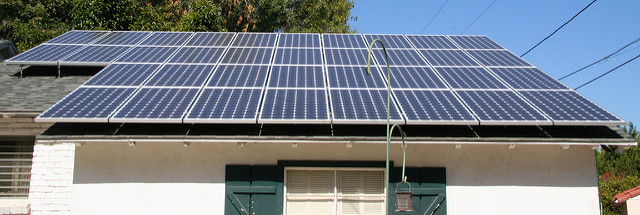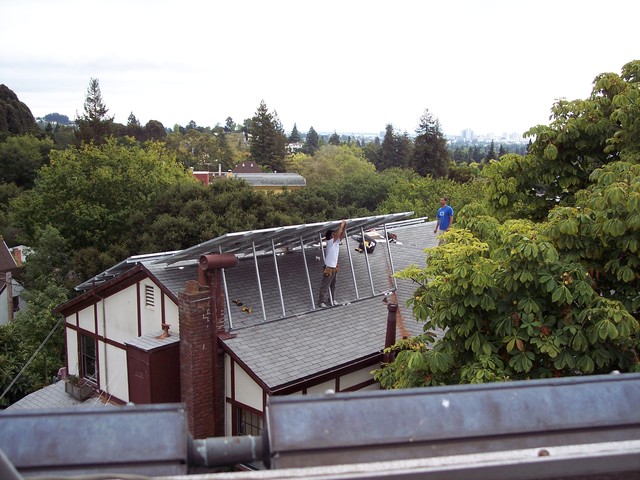Solar Panels for an Average Home: How Much?

If you’re thinking about solar panels for the home, here is what you need to know:
Before even contemplating installing solar panels for your home, one of the first things that homeowners often want to know is how much an average solar installation costs. It’s a very normal question, and you can read on for that average cost, but there is one caveat. There are so many factors that can affect an installation’s total cost that spouting off an average is not helpful – unless your home matches that average exactly, which is highly unlikely.
The best way to understand the cost of going solar is to speak with installers and get personalized quotes based on your own energy use, home size, and location.
However, the information below will give you a starting point and context for understanding your own installation’s cost.
Average Installation Costs for Solar Panels for Home: $16,400
For an average US home, total installation costs hover around $16,400 for a solar installation, before any financial incentives are applied, according to the National Renewable Energy Lab’s (NREL) 2016 benchmark of the solar industry. To find this number, NREL studied the residential solar market in California and found that the average solar installation hovered around 5.6 kilowatts (kW) – equal to about 21 solar panels – with a national average cost of $2.93/watt.
As we mentioned before, don’t assume your home is automatically the ‘average’. Your location, energy needs, and roof details could all be totally different from average.
In addition, this total cost is for a purchased solar installation, one that is not financed through a lease, loan, or power purchase agreement as is quite common in the US, and doesn’t include any incentives either. A large number of factors plays a role in determining the total installation price of a solar system.
Numerous Factors Affect Installation Cost
To really understand your costs going solar, there are many details that you or your installer need to take into account. Here are the biggest that can greatly affect your final price:
#1 – Installer
Your installer’s “soft costs” play a huge role in your total installation cost. Soft costs include everything outside of the installation equipment: Installation labor, administration, sales and marketing, office buildings, profit, permitting, and even pens and paper. Soft costs are the single biggest expense in residential installations, accounting for 58% of the total installation price, according to NREL.
Nationwide solar installers can often offer the cheapest prices. They often have streamlined services and training leading to faster through-time and their sheer size allows them to purchase equipment in bulk at discount prices. However, since most of these large companies have secured millions of dollars in financing to pay for the leases and power purchase agreements they offer homeowners, they also need to pay these back in a reasonable time frame and therefore total installation costs might be higher, something a local installer probably doesn’t have to think about.
#2 – Equipment

When assessing installing solar panels for home roofs, using more expensive or high-end equipment can increase total costs. Some homeowners prefer American-made panels, which adds cost. If your roof is small and can only fit a few panels, high-efficiency panels might be in order to make the best use of space. If your roof is heavily shaded, micro-inverters might be the best option for your installation. All of these specialty products contribute to a higher total installation cost.
A good rule of thumb is to only buy what you need. Pretty much all solar panels and inverters –regardless of quality – come with long-term warranties that back up both the physical equipment itself as well as the performance of the equipment. For example, solar panel manufacturers promise that the panel itself won’t malfunction or break for the first 12 years and that it will also produce 80% of its nameplate performance (i.e. how much electricity the company says the panel will produce when new) after 20 years.
In normal environments (your area isn’t prone to blizzards or extreme temperatures throughout the year), standard equipment performs as well as high-efficiency equipment. So if you don’t need special equipment, avoid that extra cost and go standard!
#3 – Financing Type
The type of financing you choose greatly affects the total cost over the life of your installation. The decision of which type of financing to choose is more than just a financial decision though!
Generally, homeowners will see higher savings with cash upfront purchases than with the ultra-popular solar lease or power purchase agreement. As the sole owner of the installation, homeowners are eligible to receive all the financial incentives, including the 30% federal tax credit, themselves. But they’re also responsible for all maintenance, monitoring, and repair over the life of the installation. Solar installations are fairly hands-off, so if you have the funds to pay outright for your installation, don’t be put off by the idea of maintaining and monitoring your installation. You’ll be so excited about all the clean energy you’re producing that you’ll be watching your installation’s performance no matter what financing you choose!
Don’t have the cash to invest in a solar installation upfront? Take a look at leases or PPAs then. These allow homeowners to go solar with little or no cash upfront. With leases and PPAs, the homeowner allows their solar installer to own and operate the solar installation on their roof. Then homeowner then pays the installation off in small monthly increments over the life of the agreement – typically 20 years.
If you choose the lease or PPA, you’ll have a choice between fixed monthly payments or monthly payments that increase slightly every year, known in the solar biz as an ‘escalator’. If you choose the fixed payment, your initial payments will likely be higher than your utility. However, as your utility rates increase, your monthly solar payments will remain fixed, thereby saving you big bucks over the next 20 years. With a yearly escalator, your initial monthly payments will be quite low, but as your utility’s rates increase, your monthly solar bill will also increase, though more slowly than the utility rates.
For most homeowners, getting solar with no upfront payment is by far the most attractive part of solar leases and PPAs. Since the installer is the owner of the installation, they’re also responsible for all maintenance and monitoring as well. So if you want a hands-off, easy installation with no real investment, solar leases and PPAs might be your thing!
#4 – Roof Details
![]()

The available space on your roof can also affect total installation cost. Solar panels see the highest production on south-facing roofs. If panels are installed on west or east-facing roofs, more panels will be needed, as each panel will produce less energy than if they were installed on south-facing roofs. North-facing roofs are generally avoided due to the low electricity production installed solar panels would see.
Sometimes it’s simply not possible to install on the south side of your roof. Maybe there’s a tree shading most of the area, or it’s simply too small for enough solar panels. In this case, installing panels on other sections of your roof is totally normal, but you’ll likely need a couple more panels to meet your electricity needs, as each panel will produce a little less than if it was facing south in optimal conditions!
#5 – Available Incentives
When installers work out a solar quote for homeowners, they usually include a total installation cost, as well as a net cost that includes any tax credits, net metering credits, upfront rebates, and any other financial incentives that are available. Incentives can drive the installation price down by as much as 60% in some states!
Cost Differs by State
While equipment prices are relatively constant across the US, the total pre-incentive price of an average solar installation differs by state due to differences in installation labor costs, sales and marketing costs, overhead, and profit. NREL looked at the 10 states in the US with the highest amount of solar and found a difference in total installation costs of almost $0.40/watt in some cases. This might not seem like much, but for a 5.6 kW system that difference can add up to over $2000! See the chart below highlighting the report’s findings:

Data Source: NREL
If your state isn’t listed in the study, it’s probably best to ask your local installer what the average cost is in your area, though you can certainly use the $2.93/watt average to get a ballpark figure.
Cost Decreasing Every Year
Installation costs for solar are constantly dropping every year. According to NREL’s 2016 study, the average total installation price for residential solar systems has dropped by half since 2009, from $7.06/watt to $2.93/watt. It’s estimated that the price will fall even further to around $1.60/watt by 2020.

Data Source: NREL and CleanEdge
Homeowners often worry that if they pull the trigger now and go solar, they’ll miss out on even bigger savings when the cost bottoms out next year or solar panel efficiency somehow doubles in the next 5 years. The truth of the matter is: no matter if you go solar now or later, you’ll be saving money!
With this review you should now better understand what is involved with solar panels for the home. Why not give us your feedback below regarding your own experience while making this decision?
Image Credits: Top of the page, Inverter – David Hawgood www.geograph.org.uk under Creative Commons; Pixabay; Wikimedia and Flickr
